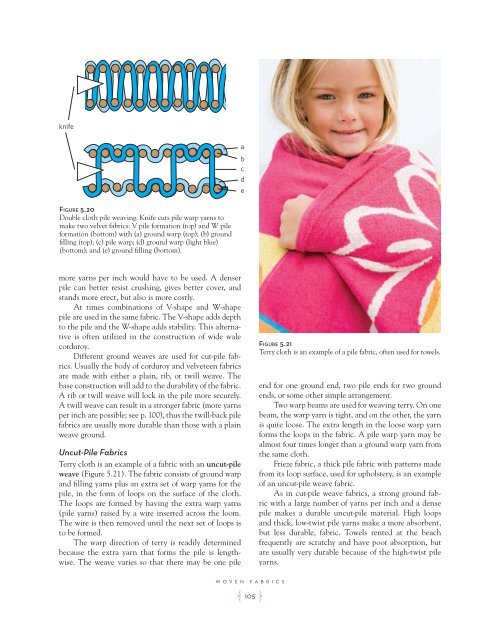Create successful ePaper yourself
Turn your PDF publications into a flip-book with our unique Google optimized e-Paper software.
knife<br />
Figure 5.20<br />
Double cloth pile weaving. Knife cuts pile warp yarns to<br />
make two velvet fabrics: V pile formation (top) and W pile<br />
formation (bottom) with (a) ground warp (top); (b) ground<br />
filling (top); (c) pile warp; (d) ground warp (light blue)<br />
(bottom); and (e) ground filling (bottom).<br />
more yarns per inch would have to be used. A denser<br />
pile can better resist crushing, gives better cover, and<br />
stands more erect, but also is more costly.<br />
At times combinations of V-shape and W-shape<br />
pile are used in the same fabric. The V-shape adds depth<br />
to the pile and the W-shape adds stability. This alternative<br />
is often utilized in the construction of wide wale<br />
corduroy.<br />
Different ground weaves are used for cut-pile fabrics.<br />
Usually the body of corduroy and velveteen fabrics<br />
are made with either a plain, rib, or twill weave. The<br />
base construction will add to the durability of the fabric.<br />
A rib or twill weave will lock in the pile more securely.<br />
A twill weave can result in a stronger fabric (more yarns<br />
per inch are possible; see p. 100), thus the twill-back pile<br />
fabrics are usually more durable than those with a plain<br />
weave ground.<br />
Uncut-Pile <strong>Fabrics</strong><br />
Terry cloth is an example of a fabric with an uncut-pile<br />
weave (Figure 5.21). The fabric consists of ground warp<br />
and filling yarns plus an extra set of warp yarns for the<br />
pile, in the form of loops on the surface of the cloth.<br />
The loops are formed by having the extra warp yarns<br />
(pile yarns) raised by a wire inserted across the loom.<br />
The wire is then removed until the next set of loops is<br />
to be formed.<br />
The warp direction of terry is readily determined<br />
because the extra yarn that forms the pile is lengthwise.<br />
The weave varies so that there may be one pile<br />
a<br />
b<br />
c<br />
d<br />
e<br />
WOVEN FABRICS<br />
A 105 F<br />
Figure 5.21<br />
Terry cloth is an example of a pile fabric, often used for towels.<br />
end for one ground end, two pile ends for two ground<br />
ends, or some other simple arrangement.<br />
Two warp beams are used for weaving terry. On one<br />
beam, the warp yarn is tight, and on the other, the yarn<br />
is quite loose. The extra length in the loose warp yarn<br />
forms the loops in the fabric. A pile warp yarn may be<br />
almost four times longer than a ground warp yarn from<br />
the same cloth.<br />
Frieze fabric, a thick pile fabric with patterns made<br />
from its loop surface, used for upholstery, is an example<br />
of an uncut-pile weave fabric.<br />
As in cut-pile weave fabrics, a strong ground fabric<br />
with a large number of yarns per inch and a dense<br />
pile makes a durable uncut-pile material. High loops<br />
and thick, low-twist pile yarns make a more absorbent,<br />
but less durable, fabric. Towels rented at the beach<br />
frequently are scratchy and have poor absorption, but<br />
are usually very durable because of the high-twist pile<br />
yarns.













